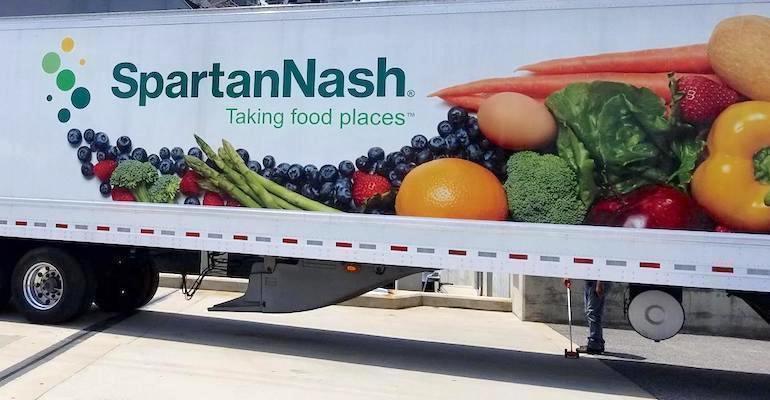SpartanNash said fourth-quarter sales were up 10.3% but net income for the quarter and year was down sharply from a year ago, driven by increased costs and other factors.
The Grand Rapids, Mich.-based retailer and wholesaler reported sales of $2.3 billion for the 12-week fourth quarter, which ended Dec. 31., and sales of $9.6 billion for the full year, an increase of 8% over year-ago levels.
Retail comparable sales increased 9.1% for the quarter and 7.7% for the fiscal year. Retail shelf-price inflation was up 11.2% in the quarter, and but item counts were down 2.1%.
The company said it expects high rates of inflation to continue, but to moderate throughout year. Unit volumes are expected to continue to remain weak, although the company said its unit volumes are outperforming the market overall.
“We’ve grown share in that space,” said Jason Monaco, executive VP and chief financial officer, in a conference call with analysts. “Throughout the year we’ve had some nice share performance, and we expect that similar trend of slightly down volumes and stronger revenues to continue to play out.”
The company said its overall basket size was up about 8.5% in dollars in the fourth quarter, which was “a little better than it was the previous couple of quarters,” said Tony Sarsam, president and CEO.
The company also saw traffic up about 1.5% vs a year ago.
“A lot of folks are looking for getting a great deal, or getting great cost on like items,” said Sarsam. “And then once in a while splurging on something unique.”
He cited the meat category as an example, where people are buying more ground beef and chicken as opposed to whole muscle beef cuts.
SpartanNash is also seeing strong growth private label sales, Sarsam said, noting that sales of the company’s own-brand products were up 18.5% in the quarter.
“That growth rate is about roughly 2.5 times the growth rate of the national brands,” he said.
The company is also focused on transforming its merchandising approach and investing in store remodels. It plans to renovate about of quarter of its stores by 2025, which will include a reintroduction of its loyalty program and holistic marketing efforts. In a handful of D&W Fresh Market stores in the Grand Rapids area, remodels are seeing sales growth rates of about 17%-plus, Sarsam said.
“We also see that we have a need to make sure that all of our stores stay current and relevant with the shopper base,” he said. “We want to make sure we have a predictable cadence of remodels that allow us to present the shopper what they want, they need as those needs change. So, you'll see more of them even after 2025.”
Net earnings down vs. a year ago
Fourth-quarter net earnings were $700,000, vs. $22.2 million in the prior-year quarter. Net earnings for the full year were down about 53.3%, to $34.5 million.
Gross profit for the quarter was $341.4 million, or 14.8% of net sales, compared to $322.7 million, or 15.4% of net sales, in the year-ago quarter. The increase was driven by higher sales, while the gross margin rate decline was driven by cycling of inflation-related price gains in the prior year and an increase in inventory expenses.
Operating expenses also increased as a percentage of sales in the quarter. They totaled $332.7 million, or 14.4% of net sales, vs. 13.8% of net sales in the year-ago quarter. The increase was primarily due to cycling the impact of a change in the company’s paid time off (PTO) policy change, which reduced the prior-year quarterly expenses by $21.4 million.
Net sales for the wholesale division increased 10.2%, to $1.63 billion, primarily to the inflationary impact on pricing, which increased net sales by 11.8% compared to the prior year, while lower case volumes decreased net sales by 1.6% compared to the prior year.
Reported operating earnings for wholesale were $300,00, compared to $10.1 million in the prior-year quarter. The decrease was due to cycling the $10.1 million transition impact of the PTO policy change in the prior year, a lower gross profit rate, primarily driven by an increase in inventory expense of $6.3 million and increases in corporate administrative costs.





